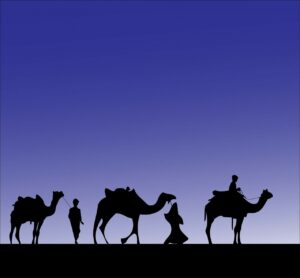A Third Way?
Debates about how men and women should function in the church have not gone away. Some (often called Complementarians) think the Bible clearly defines roles for each, and some (often called Egalitarians) think the Bible clearly gives freedom for all. Back and forth they go, often doing excellent studies of biblical texts and their background. Yet often we just lob verses across an ecclesiastical no-man’s land.
Is there another way? A way to move beyond this impasse? A way that is more, can I say, “Christian”?
There might be. Perhaps we can agree on something that can help us all move forward.
 Take what Paul says in his letter to the Galatians, for example. It’s a well-known verse often referenced in these discussions. “There is neither Jew nor Gentile, neither slave nor free, nor is there male and female, for you are all one in Christ Jesus” (Gal 3:28). This comes in the middle of a letter that is about making sure Gentiles are treated as full members in the body of Christ, not as second-class Christians. Law shouldn’t divide us, Paul says. Rather grace should unite us.
Take what Paul says in his letter to the Galatians, for example. It’s a well-known verse often referenced in these discussions. “There is neither Jew nor Gentile, neither slave nor free, nor is there male and female, for you are all one in Christ Jesus” (Gal 3:28). This comes in the middle of a letter that is about making sure Gentiles are treated as full members in the body of Christ, not as second-class Christians. Law shouldn’t divide us, Paul says. Rather grace should unite us.
The practical implication is that we should be working toward helping each other flourish in Christ as much as possible—regardless of whether we are Jew, Gentile, slave, free, men, women, young, old, rich, poor. Our aim is that all experience freedom in Christ (Gal 5:1-12) and life in the Spirit (Gal 5:13-26) to the fullest.
My point is this: regardless of our views on the roles of women in the church, at the very least Paul is asking us all to do more. Complementarians and Egalitarians can both do more to make sure women (and other groups) thrive in the grace of Christ.
 Paul’s passionate argument in Galatians calls on all of us to seriously ask questions such as, “How can we all proactively do more? What can we do to make sure that the women in our congregation are growing in Christ, learning more of his grace, growing in their love for God and others? Are there practical changes we can implement that will aid and encourage all groups (but especially those who may be sidelined, because that is Paul’s point) to more fully use their gifts for the building up of the body of Christ? How can we make sure the talents, experiences, and opinions of women are appreciated, that their dignity as people in the image of Christ is affirmed? In this context, how can we look to the interests of others first rather than our own (Phil 2:3-4)?”
Paul’s passionate argument in Galatians calls on all of us to seriously ask questions such as, “How can we all proactively do more? What can we do to make sure that the women in our congregation are growing in Christ, learning more of his grace, growing in their love for God and others? Are there practical changes we can implement that will aid and encourage all groups (but especially those who may be sidelined, because that is Paul’s point) to more fully use their gifts for the building up of the body of Christ? How can we make sure the talents, experiences, and opinions of women are appreciated, that their dignity as people in the image of Christ is affirmed? In this context, how can we look to the interests of others first rather than our own (Phil 2:3-4)?”
Of course, one of the best ways to get answers to these questions is to ask women and others, and listen to them.
Even if we don’t change our views on men and women in the church, Paul says we should seek practical ways to de-emphasize law and emphasize freedom in Christ.
Is that something we could all agree to do? How would you do it?
—
People image by Yvette W from Pixabay.
St. Louis Botanical Garden image by Andrew T. Le Peau.


 Chaos dragons are a common image in ancient near eastern literature, and the Bible writers take this and give it several twists for their own purposes. Such dragons often threaten humanity and the whole order God has created. They are associated with the disorder of the sea especially (see my
Chaos dragons are a common image in ancient near eastern literature, and the Bible writers take this and give it several twists for their own purposes. Such dragons often threaten humanity and the whole order God has created. They are associated with the disorder of the sea especially (see my  As Mackie and Collins discuss in their friendly style, these symbols represent a constellation of ideas which consider how dark forces of chaos are not the rival of God but the rival of God’s creation.
As Mackie and Collins discuss in their friendly style, these symbols represent a constellation of ideas which consider how dark forces of chaos are not the rival of God but the rival of God’s creation. 
 While the differences in Bible versions can be confusing, it’s important to remember the advantages. It means we have a variety of translations well suited for different purposes–some for public reading, some for study, and others for devotional reading. In addition, if we come across phrases like “holy kiss,” “with . . . a double heart,” “make their ears heavy”—we may be left a bit befuddled. By comparing different translations, we can sometimes get a better sense of the range of meanings in a text. 40 Questions charts dozens of translations along a continuum to show how they each wrestle with the balance of accuracy and readability in different ways.
While the differences in Bible versions can be confusing, it’s important to remember the advantages. It means we have a variety of translations well suited for different purposes–some for public reading, some for study, and others for devotional reading. In addition, if we come across phrases like “holy kiss,” “with . . . a double heart,” “make their ears heavy”—we may be left a bit befuddled. By comparing different translations, we can sometimes get a better sense of the range of meanings in a text. 40 Questions charts dozens of translations along a continuum to show how they each wrestle with the balance of accuracy and readability in different ways.

 My friends were somewhat surprised at this. They thought the text said what it meant. No more oceans.
My friends were somewhat surprised at this. They thought the text said what it meant. No more oceans.

 Further, he acts as his own intermediary. Mediators are common in such cultures. Two people who are at odds do not confront each other directly lest one loose face. The father took this risk of rejection. Indeed, having been the grievously injured party, custom would require that the father wait and aloofly receive his groveling son—which is exactly what the son expects. The father again sets aside his honor for the prospect of joyful reconciliation.
Further, he acts as his own intermediary. Mediators are common in such cultures. Two people who are at odds do not confront each other directly lest one loose face. The father took this risk of rejection. Indeed, having been the grievously injured party, custom would require that the father wait and aloofly receive his groveling son—which is exactly what the son expects. The father again sets aside his honor for the prospect of joyful reconciliation. But why does “We Three Kings” mix the minor-like Aeolian key with a chorus that is major? Is it to give the carol a Middle Eastern flavor in light of the magi coming from the east? Perhaps.
But why does “We Three Kings” mix the minor-like Aeolian key with a chorus that is major? Is it to give the carol a Middle Eastern flavor in light of the magi coming from the east? Perhaps.